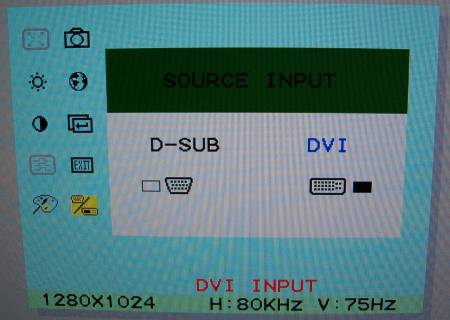OSD, Pixels and Image Quality
The on-screen display is simple to use. You press the menu button to invoke it, use the plus and minus buttons underneath for navigation to the section you want, the menu button is then a select key and when you're inside your chosen menu section, plus and minus will do your fine tuning and adjustment.
Brightness is the default menu choice when you bring the OSD up and everything is intuitive to use. It's slightly different to the OSD on the 920 PRO, probably down to using a different panel and electronics, but it's no worse off for that fact. Switching between inputs using the OSD for example, is very simple.

As you can also see, the display's default resolution and refresh rate is 1280x1024 @ 75Hz. Find more pictures here and here.
Pixels
I devoted a section of the LG review to talking about dead and stuck pixels, how they are caused and a possible remedy for certain types. I won't duplicate things here; the ProphetView II 191 BLK doesn't have any stuck or dead pixels, but I will say that the panel uses an RGB subpixel layout on its pixel array. There's a reason that's important. The LG I reviewed recently uses a BGR layout for its pixel array and therein lies the rub.ClearType is Microsoft's technology that's present in Windows XP (and their PocketPC OS releases, along with all future Microsoft OSs) that allows for subpixel aliasing, smoothing the edges of certain fonts, allowing them to look a lot nicer on sharp, bright displays like LCD TFTs. It does that by manipulating individual subpixel groups on your LCD display. It now supports BGR display types, allowing it to effectively alias the subpixel group in the correct order for displays that orient their pixels in that particular manner. The potential problem arises when running an RGB LCD display at the same time as a BGR-type display. ClearType doesn't distinguish between the two, applying either BGR or RGB ClearType aliasing across all connected displays.
I had the opportunity to run both the LG and the Hercules together for a short time and it was only possible to make one display look good, the other looking pretty bad in comparison. If you're going to be running dual LCDs, it's normal that you'll either buy them in pair or pick up an identical extra model at a later time, it's something worth looking out for. It would be cool if Microsoft could fix that particular vagary in future implementations of ClearType. Nothing particularly relevant to the Hercules, but relevant to the performance of LCDs in general.
Image Quality

The 2D display quality is subjectively excellent. Take a close look at the picture above, zoomed in so you can see the subpixels at work, performing ClearType aliasing. The aliasing is being performed correctly, without any of the bleeding demonstrated by the LG display I looked at recently. Subpixel bleed, for me at least, is utterly annoying and distracting, so its no-show on the 191 BLK is a huge sigh of relief. While it could be tuned out to a large extent on the LG, it could never be completely iradicated, something that's pretty much unacceptable on a display costing over £400. The 191 BLK will give you no such problems.









